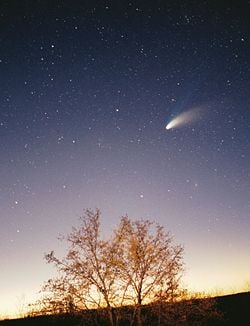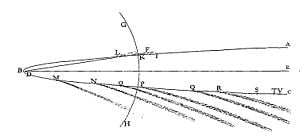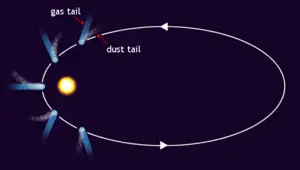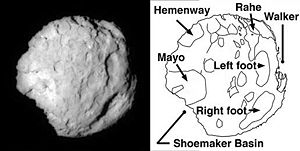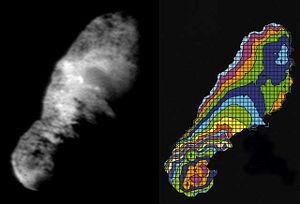Comet
A comet is a small body in the solar system that orbits the Sun and at least occasionally exhibits a "coma" (or atmosphere) and a tail. The main body of the comet, called its nucleus, may be considered a minor planet and is composed of rock, dust, and ice. The coma and tail are primarily due to the effects of solar radiation on the comet's nucleus.
Comets were formed in the outer solar system and later brought into the inner solar system by gravitational disturbance, forming highly elliptical orbits. Comets make relatively close approaches to the major planets, and their orbits are constantly changing. Some are moved into Sun-grazing orbits that destroy them when they near the Sun, while others are thrown out of the solar system forever.
Most comets are believed to originate in a cloud (the Oort cloud) at large distances from the Sun consisting of debris left over from the condensation of the solar nebula; the outer edges of such nebulae are cool enough that water exists in a solid (rather than gaseous) state. Asteroids originate via a different process, but very old comets which have lost all their volatile materials may come to resemble asteroids such as the D-type asteroids.
Physical characteristics
Long-period comets are believed to originate in a distant cloud known as the Oort cloud (after the astronomer Jan Hendrik Oort who hypothesised its existence). They are sometimes perturbed from their distant orbits by gravitational interactions, falling into extremely elliptical orbits that can bring them very close to the Sun. One theory says that as a comet approaches the inner solar system, solar radiation causes part of its outer layers, composed of ice and other materials, to melt and evaporate, but this has not been proven.
The streams of dust and gas this releases form a very large, extremely tenuous atmosphere around the comet called the coma, and the force exerted on the coma by the Sun's radiation pressure and solar wind cause an enormous tail to form, which points away from the sun. The streams of dust and gas each form their own distinct tail, each pointed in slightly different directions. The tail made of dust is left behind in the comet's orbit in such a manner that it often forms a curved tail. At the same time, the ion tail, made of gases, always pointing directly away from the Sun, as this gas is more strongly affected by the solar wind than dust is, following magnetic field lines rather than an orbital trajectory. While the solid body of comets (called the nucleus) is generally less than 50km across, the coma may be larger than the Sun, and the ion tails have been observed to extend 150 million km (1 Astronomical unit) or more.
Both the coma and tail are illuminated by the Sun, and may become visible from the Earth when a comet passes through the inner solar system, the dust reflecting sunlight directly and the gases glowing due to ionization. Most comets are too faint to be visible without the aid of a telescope, but a few each decade become bright enough to be visible with the naked eye. Before the invention of the telescope, comets seemed to appear out of nowhere in the sky and gradually vanish out of sight. They were usually considered bad omens of deaths of kings or noble men, or coming catastrophes. From ancient sources, such as Chinese oracle bones, it is known that their appearance have been noticed by humans for millennia. One very famous old recording of a comet is the appearance of Halley's Comet on the Bayeux Tapestry, which records the Norman conquest of England in 1066.[1]
Cometary nuclei are among the blackest objects known to exist in the solar system. The Giotto probe found that Comet Halley's nucleus reflects approximately 4% of the light that falls on it, and Deep Space 1 discovered that Comet Borrelly's surface reflects only 2.4% to 3% of the light that falls on it; by comparison, asphalt reflects 7% of the light that falls on it. The Tagish Lake meteorite which is believed to come from a D-type asteroid or a comet is also one of the darkest meteorites.[2] It is thought that complex organic compounds and other carbon compounds comprrise the dark surface material. Solar heating drives off volatile compounds leaving behind heavy long-chain organics that tend to be very dark, like tar or crude oil. The very darkness of cometary surfaces allows them to absorb the heat necessary to drive their outgassing.
In 1996, comets were found to emit X-rays.[3] These X-rays surprised researchers, because their emission by comets had not previously been predicted. The X-rays are thought to be generated by the interaction between comets and the solar wind: when highly charged ions fly through a cometary atmosphere, they collide with cometary atoms and molecules. In these collisions, the ions will capture one or more electrons leading to emission of X-rays and far ultraviolet photons.[4]
Orbital characteristics
Comets are classified according to their orbital periods. Short period comets have orbits of less than 200 years, while Long period comets have longer orbits but remain gravitationally bound to the Sun, and main-belt comets orbit within the asteroid belt. Single-apparition comets have parabolic or hyperbolic orbits which will cause them to permanently exit the solar system after one pass by the Sun.
Modern observations have revealed a few genuinely hyperbolic orbits, but no more than could be accounted for by perturbations from Jupiter. If comets pervaded interstellar space, they would be moving with velocities of the same order as the relative velocities of stars near the Sun (a few tens of kilometres per second). If such objects entered the solar system, they would have positive total energies, and would be observed to have genuinely hyperbolic orbits. A rough calculation shows that there might be 4 hyperbolic comets per century, within Jupiter's orbit, give or take one and perhaps two orders of magnitude.[5]
On the other extreme, the short period Comet Encke has an orbit which never places it farther from the Sun than Jupiter. Short-period comets are thought to originate in the Kuiper belt, whereas the source of long-period comets is thought to be the Oort cloud. A variety of mechanisms have been proposed to explain why comets come to develop highly elliptical orbits, including close approaches to other stars as the Sun follows its orbit through the Milky Way Galaxy; the Sun's hypothetical companion star Nemesis; or an unknown Planet X.
Because of their low masses, and their elliptical orbits which frequently take them close to the giant planets, cometary orbits are often disturbed. It is clear that comets coming in from the Oort cloud often have their orbits strongly influenced by the gravity of giant planets as a result of a close encounter. Jupiter is the source of the greatest influence, being more than twice as massive as all the other planets combined, in addition to being the swiftest of the giant planets.
A number of periodic comets discovered in earlier decades or previous centuries are now "lost." Their orbits were never known well enough to predict future appearances. However, occasionally a "new" comet will be discovered and upon calculation of its orbit it turns out to be an old "lost" comet. An example is Comet 11P/Tempel-Swift-LINEAR, discovered in 1869 but unobservable after 1908 due to perturbations by Jupiter. It was not found again until accidentally rediscovered by LINEAR in 2001.[6]
Comet nomenclature
The names given to comets have followed several different conventions over the past two centuries. Before any systematic naming convention was adopted, comets were named in a variety of ways. Prior to the early 20th century, most comets were simply referred to by the year in which they appeared, sometimes with additional adjectives for particularly bright comets; thus, the "C/1680 V1|Great Comet of 1680" (Kirch's Comet), the "C/1882 R1|Great September Comet of 1882," and the "Great Daylight Comet of 1910|Daylight Comet of 1910" ("Great January Comet of 1910"). After Edmund Halley demonstrated that the comets of 1531, 1607, and 1682 were the same body and successfully predicted its return in 1759, that comet became known as Comet Halley. Similarly, the second and third known periodic comets, Comet Encke and Comet Biela, were named after the astronomers who calculated their orbits rather than their original discoverers. Later, periodic comets were usually named after their discoverers, but comets that had appeared only once continued to be referred to by the year of their apparition.
In the early 20th century, the convention of naming comets after their discoverers became common, and this remains so today. A comet is named after up to three independent discoverers. In recent years, many comets have been discovered by instruments operated by large teams of astronomers, and in this case, comets may be named for the instrument. For example, C/1983 H1|Comet IRAS-Araki-Alcock was discovered independently by the IRAS satellite and amateur astronomers Genichi Araki and George Alcock. In the past, when multiple comets were discovered by the same individual, group of individuals, or team, the comets' names were distinguished by adding a numeral to the discoverers' names; thus Comets Shoemaker-Levy 1–9. Today, the large numbers of comets discovered by some instruments (in August 2005, SOHO discovered its 1000th comet[7]) has rendered this system impractical, and no attempt is made to ensure that each comet has a unique name. Instead, the comets' systematic designations are used to avoid confusion.
Until 1994, comets were first given a provisional designation consisting of the year of their discovery followed by a lowercase letter indicating its order of discovery in that year (for example, C/1969 Y1|Comet Bennett 1969i was the 9th comet discovered in 1969). Once the comet had been observed through perihelion and its orbit had been established, the comet was given a permanent designation of the year of its perihelion, followed by a Roman numeral indicating its order of perihelion passage in that year, so that Comet Bennett 1969i became Comet Bennett 1970 II (it was the second comet to pass perihelion in 1970)[8]
Increasing numbers of comet discoveries made this procedure awkward, and in 1994 the International Astronomical Union approved a new naming system. Comets are now designated by the year of their discovery followed by a letter indicating the half-month of the discovery and a number indicating the order of discovery (a system similar to that already used for asteroids), so that the fourth comet discovered in the second half of February 2006 would be designated 2006 D4. Prefixes are also added to indicate the nature of the comet, with P/ indicating a periodic comet, C/ indicating a non-periodic comet, X/ indicating a comet for which no reliable orbit could be calculated, D/ indicating a comet which has broken up or been lost, and A/ indicating an object that was mistakenly identified as a comet, but is actually a minor planet. After their second observed perihelion passage, periodic comets are also assigned a number indicating the order of their discovery.[9] So Halley's Comet, the first comet to be identified as periodic, has the systematic designation 1P/1682 Q1. Comet Hale-Bopp's designation is C/1995 O1.
There are only four objects that are cross-listed as both comets and asteroids: 2060 Chiron (95P/Chiron), 133P/Elst-Pizarro (7968 Elst-Pizarro), 60558 Echeclus (174P/Echeclus) and 4015 Wilson-Harrington (107P/Wilson-Harrington).
History of comet study
Early observations and thought
Historically, comets were thought to be unlucky, or even interpreted as attacks by heavenly beings against terrestrial inhabitants. Some authorities interpret references to "falling stars" in Gilgamesh, Revelation and the Book of Enoch as references to comets, or possibly bolides.
In the first book of his Meteorology, Aristotle propounded the view of comets that would hold sway in Western thought for nearly two thousand years. He rejected the ideas of several earlier philosophers that comets were planets, or at least a phenomenon related to the planets, on the grounds that while the planets confined their motion to the circle of the Zodiac, comets could appear in any part of the sky.[10] Instead, he described comets as a phenomenon of the upper atmosphere, where hot, dry exhalations gathered and occasionally burst into flame. Aristotle held this mechanism responsible for not only comets, but also meteors, the aurora borealis, and even the Milky Way.
A few later classical philosophers did dispute this view of comets. Seneca the Younger, in his Natural Questions, observed that comets moved regularly through the sky and were undisturbed by the wind, behavior more typical of celestial than atmospheric phenomena. While he conceded that the other planets do not appear outside the Zodiac, he saw no reason that a planet-like object could not move through any part of the sky, humanity's knowledge of celestial things being very limited.[11] However, the Aristotelean viewpoint proved more influential, and it was not until the 16th century that it was demonstrated that comets must exist outside the earth's atmosphere.
In 1577, a bright comet was visible for several months. The Danish astronomer Tycho Brahe used measurements of the comet's position taken by himself and other, geographically separated, observers to determine that the comet had no measureable parallax. Within the precision of the measurements, this implied the comet must be at least four times more distant from the earth than the moon.[12]
Orbital studies
Although comets had now been demonstrated to be in the heavens, the question of how they moved through the heavens would be debated for most of the next century. Even after Johannes Kepler had determined in 1609 that the planets moved about the sun in elliptical orbits, he was reluctant to believe that the laws that governed the motions of the planets should also influence the motion of other bodies — he believed that comets travel among the planets along straight lines. Galileo Galilei, although a staunch Copernicanist, rejected Tycho's parallax measurements and held to the Aristotelean notion of comets moving on straight lines through the upper atmosphere.[13]
The first suggestion that Kepler's laws of planetary motion should also apply to the comets was made by William Lower in 1610. In the following decades, other astronomers, including Pierre Petit, Giovanni Borelli, Adrien Auzout, Robert Hooke, Johann Baptist Cysat, and Giovanni Domenico Cassini, all argued for comets curving about the sun on elliptical or parabolic paths, while others, such as Christian Huygens and Johannes Hevelius, supported comets' linear motion.[13]
The matter was resolved by the bright comet that was discovered by Gottfried Kirch on November 14, 1680. Astronomers throughout Europe tracked its position for several months. In 1681, the Saxon pastor Georg Samuel Doerfel set forth his proofs that comets are heavenly bodies moving in parabolas of which the sun is the focus. Then Isaac Newton, in his Principia Mathematica of 1687, proved that an object moving under the influence of his inverse square law of universal gravitation must trace out an orbit shaped like one of the conic sections, and he demonstrated how to fit a comet's path through the sky to a parabolic orbit, using the comet of 1680 as an example.[14]
In 1705, Edmond Halley applied Newton's method to twenty-four cometary apparitions that had occurred between 1337 and 1698. He noted that three of these, the comets of 1531, 1607, and 1682, had very similar orbital elements, and he was further able to account for the slight differences in their orbits in terms of gravitational influence by Jupiter and Saturn. Confident that these three apparitions had been three appearances of the same comet, he predicted that it would appear again in 1758-9.[15] (Earlier, Robert Hooke had identified the comet of 1664 with that of 1618,[16] while Jean-Dominique Cassini had suspected the identity of the comets of 1577, 1665, and 1680. Both were incorrect.) Halley's predicted return date was later refined by a team of three French mathematicians: Alexis Clairaut, Joseph Lalande, and Nicole-Reine Lepaute, who predicted the date of the comet's 1759 perihelion to within one month's accuracy. When the comet returned as predicted, it became known as Comet Halley or Halley's Comet (its official designation is 1P/Halley). Its next appearance is due in 2061.
Among the comets with short enough periods to have been observed several times in the historical record, Comet Halley is unique in consistently being bright enough to be visible to the naked eye. Since the confirmation of Comet Halley's periodicity, many other periodic comets have been discovered through the telescope. The second comet to be discovered to have a periodic orbit was Comet Encke (official designation 2P/Encke). Over the period 1819-1821 the German mathematician and physicist Johann Franz Encke computed orbits for a series of cometary apparitions observed in 1786, 1795, 1805, and 1818, concluded they were same comet, and successfully predicted its return in 1822. By 1900, seventeen comets had been observed at more than one perihelion passage and recognized as periodic comets. As of April 2006, 175 comets have achieved this distinction, though several have since been destroyed or lost.
Studies of physical characteristics
Isaac Newton described comets as compact, solid, fixed, and durable bodies: in other words, a kind of planet, which move in very oblique orbits, every way, with the greatest freedom, persevering in their motions even against the course and direction of the planets; and their tail as a very thin, slender vapour, emitted by the head, or nucleus of the comet, ignited or heated by the sun. Comets also seemed to Newton absolutely requisite for the conservation of the water and moisture of the planets; from their condensed vapours and exhalations all that moisture which is spent on vegetations and putrefactions, and turned into dry earth, might be resupplied and recruited; for all vegetables were thought to increase wholly from fluids, and turn by putrefaction into earth. Hence the quantity of dry earth must continually increase, and the moisture of the globe decrease, and at last be quite evaporated, if it have not a continual supply. Newton suspected that the spirit which makes the finest, subtilest, and best part of our air, and which is absolutely requisite for the life and being of all things, came principally from the comets.
As early as the 18th century, some scientists had made correct hypotheses as to comets' physical composition. In 1755, Immanuel Kant hypothesized that comets are composed of some volatile substance, whose vaporization gives rise to their brilliant displays near perihelion. In 1836, the German mathematician Friedrich Wilhelm Bessel, after observing streams of vapor in the 1835 apparition of Comet Halley, proposed that the jet forces of evaporating material could be great enough to significantly alter a comet's orbit and argued that the non-gravitational movements of Comet Encke resulted from this mechanism.
However, another comet-related discovery overshadowed these ideas for nearly a century. Over the period 1864–1866 the Italian astronomer Giovanni Schiaparelli computed the orbit of the Perseid meteors, and based on orbital similarities, correctly hypothesized that the Perseids were fragments of Comet Swift-Tuttle. The link between comets and meteor showers was dramatically underscored when in 1872, a major meteor shower occurred from the orbit of Comet Biela, which had been observed to split into two pieces during its 1846 apparition, and never seen again after 1852. A "gravel bank" model of comet structure arose, according to which comets consist of loose piles of small rocky objects, coated with an icy layer.
By the middle of the twentieth century, this model suffered from a number of shortcomings: in particular, it failed to explain how a body that contained only a little ice could continue to put on a brilliant display of evaporating vapor after several perihelion passages. In 1950, Fred Lawrence Whipple proposed that rather than being rocky objects containing some ice, comets were icy objects containing some dust and rock.[17] This "dirty snowball" model soon became accepted. It was confirmed when an armada of spacecraft (including the European Space Agency's Giotto probe and the Soviet Union's Vega 1 and Vega 2) flew through the coma of Halley's comet in 1986 to photograph the nucleus and observed the jets of evaporating material. The American probe Deep Space 1 flew past the nucleus of Comet Borrelly on September 21, 2001 and confirmed that the characteristics of Comet Halley are common on other comets as well.
The Stardust spacecraft, launched in February 1999, collected particles from the coma of Comet Wild 2 in January 2004, and returned the samples to Earth in a capsule in January 2006. Claudia Alexander, a program scientist for Rosetta from NASA's Jet Propulsion Laboratory who has has modeled comets for years, reported to space.com about her astonishment at the number of jets, their appearance on the dark side of the comet as well as on the light side, their ability to lift large chunks of rock from the surface of the comet and the fact that comet Wild 2 is not a loosely-cemented rubble pile.[18]
Forthcoming space missions will add greater detail to our understanding of what comets are made of. In July 2005, the Deep Impact probe blasted a crater on Comet Tempel 1 to study its interior. And in 2014, the European Rosetta probe will orbit comet Comet Churyumov-Gerasimenko and place a small lander on its surface.
Rosetta observed the Deep Impact event, and with its set of very sensitive instruments for cometary investigations, it used its capabilities to observe Tempel 1 before, during and after the impact. At a distance of about 80 million kilometres from the comet, Rosetta was in the most privileged position to observe the event. Rosetta measured the water vapour content and the cross-section of the dust created by the impact. European scientists could then work out the corresponding dust/ice mass ratio, which is larger than one, suggesting that comets are composed more of dust held together by ice, rather than made of ice comtaminated with dust. Hence, they are now 'icy dirtballs' rather than 'dirty snowballs' as previously believed.
Debate over comet composition
As late as 2002, there is conflict on how much ice is in a comet. NASA's Deep Space 1 team, working at NASA's Jet Propulsion Lab, obtained high-resolution images of the surface of comet Borrelly. They announced that comet Borrelly exhibits distinct jets, yet has a hot, dry surface. The assumption that comets contain water and other ices led Dr. Laurence Soderblom of the U.S. Geological Survey to say, "The spectrum suggests that the surface is hot and dry. It is surprising that we saw no traces of water ice." However, he goes on to suggest that the ice is probably hidden below the crust as "either the surface has been dried out by solar heating and maturation or perhaps the very dark soot-like material that covers Borrelly's surface masks any trace of surface ice".[19]
The recent Deep Impact probe has also yielded preliminary results suggesting there is less ice in comets than originally predicted.
Peculiar comets
Of the thousands of known comets, some are very unusual. Comet Encke orbits from inside the orbit of Jupiter to inside the orbit of Mercury while Comet 29P/Schwassmann-Wachmann orbits in a nearly circular orbit entirely between Jupiter and Saturn. 2060 Chiron, whose unstable orbit keeps it between Saturn and Uranus, was originally classified as an asteroid until a faint coma was noticed. Similarly, Comet Shoemaker-Levy 2 was originally designated asteroid 1990 UL3. Some near-Earth asteroids are thought to be extinct nuclei of comets which no longer experience outgassing.
Some comets have been observed to break up. Comet Biela was one significant example, breaking into two during its 1846 perihelion passage. The two comets were seen separately in 1852, but never again after that. Instead, spectacular meteor showers were seen in 1872 and 1885 when the comet should have been visible. A lesser meteor shower, the Andromedids, occurs annually in November, and is caused by the Earth crossing Biela's orbit.[20]
Several other comets have been seen to break up during their perihelion passage, including great comets West and Comet Ikeya-Seki. Some comets, such as the Kreutz Sungrazers, orbit in groups and are thought to be pieces of a single object that has previously broken apart.
Another very significant cometary disruption was that of Comet Shoemaker-Levy 9, which was discovered in 1993. At the time of its discovery, the comet was in orbit around Jupiter, having been captured by the planet during a very close approach in 1992. This close approach had already broken the comet into hundreds of pieces, and over a period of 6 days in July 1994, these pieces slammed into Jupiter's atmosphere — the first time astronomers had observed a collision between two objects in the solar system. However, it has been suggested that the object responsible for the Tunguska event in 1908 was a fragment of Comet Encke.
ReferencesISBN links support NWE through referral fees
- ↑ "Britain's Bayeux Tapestry, scene 1," Reading Museum Service, 2000-2004, Accessed on 2005-03-22.
- ↑ Hiroi, T., Zolensky, M.E., and Pieters, C.M. (2001) The Tagish Lake meteorite: A possible sample from a D-type asteroid. Science 293, 2234-2236.
- ↑ First X-Rays from a Comet Discovered Accessed on 2006-03-05.
- ↑ Probing space weather with comets Accessed on 2006-03-05.
- ↑ Cowley lecture 34 Accessed on 2005-03-05; 404 error as of last access.
- ↑ "Cometography" Gary W. Kronk, '11P/Tempel-Swift-LINEAR', 2001–2005 Accessed on 2006-03-05.
- ↑ The SOHO 1000th Comet Contest Solar and Heliospheric Observatory, 2005. Accessed on 2006-03-05.
- ↑ Astronomical Names Bill Arnett, 2000. Accessed on 2006-03-05.
- ↑ Cometary Designation System Committee on Small Body Nomenclature, 1994. Accessed on 2006-03-05.
- ↑ Meteorologia l.1.c.6., Aristotle, 350 B.C.E.
- ↑ Sagan, Carl, and Druyan, Ann, Comet, New York: Random House, 1985, pp. 23-24. ISBN 0-394-54908-2.
- ↑ A Brief History of Comets, part I European Southern Observatory, 2003.
- ↑ 13.0 13.1 Prasar, V. (2001) Development of Cometary Thought, Part II
- ↑ Newton, I.S. (1687) Philosophiæ Naturalis Principia Mathematica, Josephi Streater, London.
- ↑ Halleio, E. (1705) Astronomiæ Cometicæ Synopsis, Philosophical Transactions 24, 1882–1899
- ↑ Pepys, S. (1893) The Diary of Samuel Pepys, M.A., F.R.S., George Bell & Sons, London.
- ↑ Whipple, F.L. (1950) A Comet Model I. The Acceleration of Comet Encke, Astrophysical Journal 111, 375–394.
- ↑ Strange Comet Unlike Anything Known
- ↑ NASA Spacecraft Finds Comet Has Hot, Dry Surface
- ↑ The Andromedids ("Bielids")
External links
- A Brief History of Comets: Part I, Part II
- Development of Cometary Thought: Part I, Part II
- Cometography.com
- David Jewitt overview of the comets
- Listing of newly discovered comets
- Everything you wanted to know about comets and asteroids — Provided by New Scientist.
- Source of useful comet-related material on the Web
- Open Directory Project: Comets
Credits
New World Encyclopedia writers and editors rewrote and completed the Wikipedia article in accordance with New World Encyclopedia standards. This article abides by terms of the Creative Commons CC-by-sa 3.0 License (CC-by-sa), which may be used and disseminated with proper attribution. Credit is due under the terms of this license that can reference both the New World Encyclopedia contributors and the selfless volunteer contributors of the Wikimedia Foundation. To cite this article click here for a list of acceptable citing formats.The history of earlier contributions by wikipedians is accessible to researchers here:
The history of this article since it was imported to New World Encyclopedia:
Note: Some restrictions may apply to use of individual images which are separately licensed.
